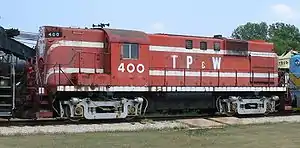ALCO RS-11
The ALCO RS-11 is a diesel-electric locomotive of the road switcher type rated at 1,800 hp (1.34 MW), that rode on two-axle trucks, having a B-B wheel arrangement. This model was built by both Alco (355 units) and Montreal Locomotive Works (76 units). Total production was 431 units.
| ALCO RS-11 | |||||||||||||||||||||||||||||||||||||||||||
|---|---|---|---|---|---|---|---|---|---|---|---|---|---|---|---|---|---|---|---|---|---|---|---|---|---|---|---|---|---|---|---|---|---|---|---|---|---|---|---|---|---|---|---|
 TPW 400, an RS-11 on display at Illinois Railway Museum, July 16, 2005. | |||||||||||||||||||||||||||||||||||||||||||
| |||||||||||||||||||||||||||||||||||||||||||
| |||||||||||||||||||||||||||||||||||||||||||
| |||||||||||||||||||||||||||||||||||||||||||
| |||||||||||||||||||||||||||||||||||||||||||
Development
The first three RS-11s were produced by ALCO in February 1956 as a demonstrator set. This locomotive, classified by ALCO as model DL-701, was their first high-horsepower road switcher,[1] intended to be a replacement for the very popular RS-3 road switcher. Featuring a V-12, 1,800 hp (1,300 kW) 251B diesel engine, the RS-11 was ALCO's answer to EMD's very successful GP9. The turbocharged RS-11 accelerated faster, had a higher tractive effort rating and typically used less fuel than the competition. It was also quite versatile and could be found in heavy haul freight as well as passenger service. It was produced in high-nose and low-nose versions. Montreal Locomotive Works also built nearly identical units, known as the RS-18, predominantly for the Canadian market.[1]
While the RS-11 benefited from the increased power and reliability offered with ALCO's new 251B engine, and was arguably a more advanced product than the GP9, its market acceptance was disappointing against the reputation EMD's locomotives had made for superior reliability.
Original purchasers
| Owner | Quantity | Numbers | Notes |
|---|---|---|---|
| Alco | 3 | 701, 701A, 701B | first RS11s built, sold to Southern Pacific, 701B steam generator |
| Carolina and Northwestern Railway | 1 | 11 | |
| Delaware and Hudson | 12 | 5000-5011 | 5000-5005 built as New York Central 8009-8014, 5006-5011 low nose |
| Duluth, Winnipeg and Pacific | 15 | 3600-3614 | |
| Erie Mining | 15 | 300-314 | |
| Ferrocarril del Pacifico | 1 | 1501 | built by Montreal Locomotive Works, steam generator |
| Ferrocarriles Nacionales de México | 94 | 7200-7293 | 7205-7217 steam generator, 7218-7293 built by Montreal Locomotive Works, low nose, last built |
| Green Bay and Western | 1 | 309 | |
| Lehigh Valley Railroad | 4 | 400-403 | low nose |
| Maine Central | 1 | 801 | Portland Terminal 1082 to Maine Central 802 |
| Ministry of Communication and Transportation (Mexico) | 4 | 7123-1 - 7123-4 | 7123-4 steam generator |
| Missouri Pacific | 12 | 4601-4612 | |
| Monongahela Connecting Railroad | 1 | 700 | |
| New York, New Haven and Hartford | 15 | 1400-1414 | steam generators |
| New York Central | 9 | 8000-8008 | to Penn Central then to Conrail and Rebuild to MT4's and 2 to Norfolk Southern |
| New York, Chicago and St. Louis Railroad | 35 | 558-577, 850-864 | |
| Norfolk and Western | 99 | 308-406 | |
| Northern Pacific | 18 | 900-917 | |
| Pennsylvania | 38 | 8617-8654 | 8640-8644, 8648 leased to Lehigh Valley 7640-7644, 7648 in 1964; 8617/8654 to Penn Central then remaining LV and PC to Conrail. Some rebuilt to MT4 slugs. |
| Portland Terminal | 1 | 1082 | to Maine Central 802 |
| Seaboard Air Line | 10 | 100-109 | to SCL 1202-1211, all transferred to Louisville & Nashville in August 1976 and renumbered to L&N 950-959. |
| Southern Peru Copper Corp. | 5 | 3-6, 8 | |
| Southern Pacific Railroad | 34 | 5723-5729, 5845-5871 | 5866-5871 low nose, purchased Alco Demonstrators to SP 5720-5722 |
| Toledo, Peoria and Western Railway | 3 | 400-402 | 401 rebuilt by Alco after a wreck with low nose |
| Total | 431 |
References
- Foster, Gerald (1996). A Field Guide to Trains. Boston, New York: Houghton Mifflin Company. pp. 26. ISBN 0395701120.
- Dorin, Patrick C. (1972). Chicago and North Western Power. Burbank, California: Superior Publishing. p. 144. ISBN 0-87564-715-4.
- Steinbrenner, Richard T. (2003). The American Locomotive Company: A Centennial Remembrance. On Track Publishers, LLC. ISBN 0-911122-07-9.
- http://www.trainweb.org/jaydeet/rs11.htm
- Roster from The Diesel Shop http://www.thedieselshop.us/Alco_RS11.HTML